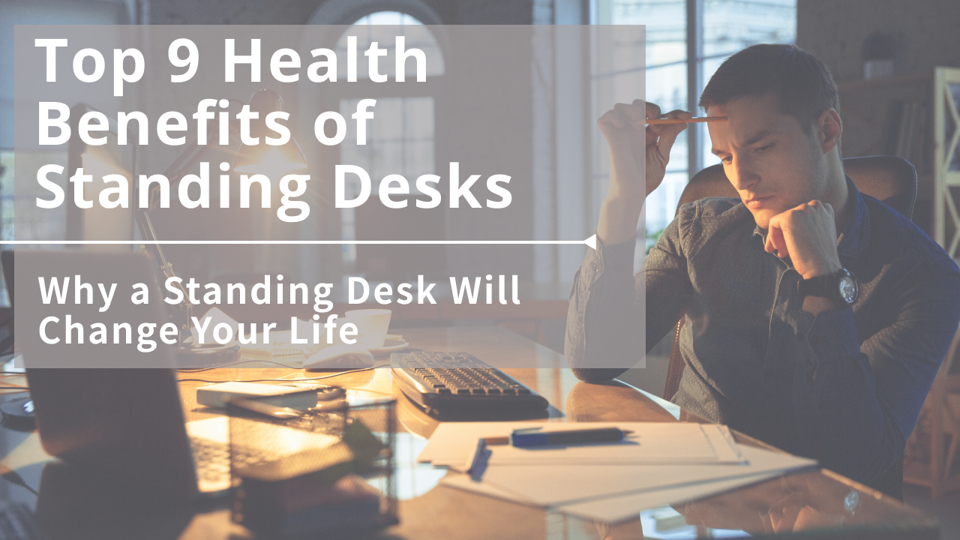Top 9 Benefits of Standing Desks: Why It Supports Health
02/25/2024Discover the top 9 health benefits of standing desks and learn how they can improve your posture, reduce back pain, and boost productivity as you work.

Table of Contents
In the modern workplace, the adverse effects of prolonged sitting have become a significant concern, contributing to a range of health issues from back pain to increased risk of chronic diseases. As a response, standing desks have emerged as a popular solution, offering a more dynamic and health-conscious approach to work. Whether you are a seasoned professional or just beginning to explore ergonomic options, understanding the benefits and proper use of standing desks is crucial for enhancing both your well-being and productivity.
In this comprehensive guide, we will delve into what standing desks are, explore the numerous health benefits they provide, and offer practical tips for their effective use. From reducing the risk of heart disease to improving posture and boosting productivity, standing desks can transform your workday and overall health. Join us as we unpack everything you need to know about standing desks and how to integrate them into your daily routine for optimal results.
What is a Standing Desk?

Photo by TheStandingDesk on Unsplash
A standing desk, also known as a height-adjustable desk, sit-stand desk, or stand-up desk, allows users to work comfortably while standing. Modern versions of these desks are designed to be adjustable, enabling users to switch between sitting and standing throughout the day. This adjustability caters to ergonomic needs, promoting better posture and reducing the adverse effects of prolonged sitting. Standing desks are now equipped with advanced features like levers for height adjustment, eye-level monitors, and wrist pads, ensuring a comfortable and health-conscious work environment. By integrating biotechnology and design engineering, standing desks offer significant physical and mental health benefits, making them a superior choice for enhancing productivity and well-being in the workplace.
9 Health Benefits of Standing Desks

Standing desks have revolutionized the modern workplace, offering a myriad of health benefits that extend far beyond traditional seating arrangements. These desks support a healthier, more active lifestyle, from alleviating chronic pain to enhancing cardiovascular health. By integrating standing desks into daily routines, individuals can significantly improve their physical well-being, boost productivity, and enjoy a more dynamic work environment. If you're still unsure about purchasing a standing desk, this section will highlight the physical and mental benefits. Join us as we explore how standing desks can enhance your health and well-being.
1.Reduce the Back and Neck Pain

Image by Freepik
Standing desks are increasingly recognized for their role in reducing back and neck pain, a common affliction among office workers who sit for prolonged periods. When seated for long durations, undue pressure is placed on the lower back, potentially leading to significant discomfort and even chronic conditions. Additionally, improper monitor placement can cause neck strain due to awkward head tilting. Standing desks offer an ergonomic solution by encouraging a dynamic posture. Alternating between sitting and standing mitigates the continuous strain on the back, neck, and shoulders, fostering better spinal health.
The research underscores the effectiveness of standing desks in alleviating pain. Studies reveal that employees using standing desks reported a 32% improvement in lower back pain and a 54% reduction in upper back and neck pain within just four weeks. The removal of these desks, however, saw a reversal in pain reduction, highlighting the importance of consistent use. Moreover, standing desks promote better posture and reduce the risk of disc damage and shoulder tension. Therefore, incorporating a standing desk into your daily routine can significantly diminish the discomfort associated with sedentary work environments, leading to enhanced overall well-being.
2. Improve Circulation

Photo by TheStandingDesk on Unsplash
Standing desks are instrumental in enhancing circulation, which is a crucial aspect of maintaining overall health. Prolonged sitting can significantly impede blood flow, leading to various health issues such as swollen ankles, blood clots, peripheral neuropathy, and varicose veins. By contrast, standing desks encourage regular movement and a dynamic posture, promoting better blood flow to the extremities. This improved circulation helps prevent the stagnation of blood, which is often associated with cardiovascular problems and reduced life spans.
The act of standing activates leg muscles, enhances balance, and strengthens the core, all of which contribute to a healthier circulatory system. Additionally, incorporating small movements such as stretching or walking while using a standing desk can further boost blood flow and prevent the formation of blood clots. Therefore, the use of standing desks not only supports better circulation but also integrates seamlessly into a healthier lifestyle, reducing the risks associated with sedentary behavior.
3. Burn More Calories: Lowering Risks of Weight Gain and Obesity

Photo by Onur Binay on Unsplash
Standing desks are a valuable tool in combating weight gain and obesity by helping users burn more calories throughout the day. While exercise remains the most effective method for rapid calorie burning, standing instead of sitting can contribute significantly to daily energy expenditure. Studies show that standing burns about 100-200 calories per hour, compared to 60-130 calories burned while sitting. This difference might seem modest on an hourly basis, but over time, it accumulates, leading to substantial caloric expenditure. For instance, standing for just three hours a day for five days a week can burn up to 750 calories, equating to the caloric burn of running several marathons annually.
Moreover, standing promotes a mindset oriented towards wellness, encouraging additional physical activities like walking, stretching, or doing light exercises during breaks. Research indicates that individuals who incorporate more movement into their daily routine—such as standing and walking—are less likely to gain weight compared to those who remain sedentary. In fact, simply standing at your desk each afternoon can burn over 170 additional calories, potentially resulting in nearly 1,000 extra calories burned per week. Thus, integrating standing desks into the workplace is an effective strategy to lower the risks of weight gain and obesity by promoting consistent, moderate physical activity throughout the day.
4. Lower Blood Sugar Level

Image by Freepik
Standing desks offer a significant benefit in lowering blood sugar levels, particularly after meals. Post-meal blood sugar spikes are harmful, especially for individuals with insulin resistance or diabetes. Research indicates that standing for three hours after lunch can reduce these spikes by 43% compared to sitting for the same duration. This reduction occurs without additional physical activity, highlighting the direct impact of standing on blood sugar regulation.
Furthermore, alternating between sitting and standing every 30 minutes throughout the workday can reduce blood sugar spikes by 11% on average. This approach helps mitigate the negative effects of prolonged sedentary time, which is associated with a significantly higher risk of type 2 diabetes. Implementing a sit-stand routine, especially after meals, can thus be a practical and effective strategy for maintaining healthier blood sugar levels and reducing the risk of metabolic diseases.
5. Reduce the Risk of Heart Disease
Standing desks play a significant role in reducing the risk of heart disease, a benefit supported by extensive research dating back to the 1950s. A landmark study conducted in 1953 revealed that London bus conductors, who stood throughout their shifts, had significantly lower rates of heart disease compared to their seated counterparts, the bus drivers. This early evidence has been consistently reinforced by subsequent studies highlighting the cardiovascular risks associated with prolonged sitting.
Modern research indicates that adults who sit for extended periods each day have a 125% increased risk of health issues related to cardiovascular disease, including heart attacks and chest pain. Even with regular intense exercise, the detrimental effects of prolonged sitting are not fully mitigated. Standing more throughout the day helps counteract these risks by promoting better cardiovascular health. Incorporating a standing desk into your routine can therefore be a practical and effective strategy to lower the risk of heart disease, emphasizing the importance of reducing sedentary behavior for heart health.
6. Reduced Risk of Chronic Diseases
Standing desks contribute significantly to a longer lifespan by reducing sedentary time, which is closely linked to several severe health issues. Prolonged sitting increases the risk of heart disease, cancer, and diabetes, all of which can negatively impact life expectancy. Studies have shown that reducing sitting time lowers these risks, thereby enhancing longevity. According to the American Cancer Society, women and men who sat more and were less physically active had a 94% and 48% higher likelihood, respectively, of dying compared to their more active counterparts who sat less.
The comprehensive health benefits of using a standing desk, both physical and mental, contribute to an overall increase in life expectancy. By addressing the issues associated with a sedentary lifestyle, standing desks help improve well-being and reduce the risk of various health conditions. This proactive approach to health not only enhances daily quality of life but also promotes a longer, healthier lifespan.
7. Enhance Mood and Focus

Image by Freepik
Standing desks significantly enhance mood and focus, offering a valuable boost in energy and productivity. A 7-week study revealed that participants using standing desks experienced less stress and fatigue compared to those seated all day. An impressive 87% reported increased vigor and energy, with overall mood improvements reverting back to initial levels when they returned to sitting desks. This aligns with broader research linking prolonged sitting with heightened risks of depression and anxiety.
Further reinforcing these benefits, a study from Texas A&M University found that employees in a call center who used standing desks were 50% more productive. Standing helps maintain better blood flow, sending more oxygen to muscles and the brain, which keeps you alert and focused. Workers reported feeling more engaged and energized, with 66% noting increased productivity and 87% feeling more energetic after incorporating standing periods into their workday. This combination of physical activity and mental stimulation makes standing desks a powerful tool for enhancing workplace well-being.
8. Boost Productivity

Photo by Sable Flow on Unsplash
Standing desks have been shown to significantly enhance productivity in the workplace. Contrary to concerns that standing might hinder daily tasks such as typing, studies reveal no significant impact on typing speed or accuracy. In a study involving 60 young office workers, using a standing desk for four hours daily did not affect the number of characters typed per minute or the number of typing errors made. This indicates that the transition to standing desks is smooth and does not interfere with task performance.
Moreover, the indirect benefits of standing desks play a crucial role in boosting productivity. Standing improves mood, energy levels, and overall well-being. When employees are free from discomfort, such as back, neck, or shoulder pain, they can concentrate better on their tasks. Enhanced mood and increased energy lead to more efficient work performance, ultimately resulting in a more productive workday. Integrating standing desks into the workplace not only supports physical health but also fosters a more dynamic and productive environment.
9. Improve Posture
Standing desks offer substantial benefits for improving posture and reducing strain on the spine. Prolonged sitting can place significant stress on the spine, contributing to lower back and neck pain. By opting to stand intermittently throughout the day, individuals can alleviate this strain and promote a more natural spinal alignment characterized by an ergonomic "S" shape. Proper ergonomics while standing are crucial to maximizing these benefits, ensuring that the spine remains elongated and well-supported. Adjusting the desk height appropriately and alternating between sitting and standing at regular intervals can prevent fatigue and further enhance posture over time.
Moreover, standing desks encourage a more ergonomic position for the arms and wrists. Maintaining a comfortable 90-100-degree angle in the arms while standing can reduce wrist strain and potentially enhance typing efficiency. This ergonomic advantage not only supports better posture but also contributes to overall comfort and productivity during work hours. By integrating standing into daily routines with proper adjustments, individuals can mitigate the negative effects of prolonged sitting and enjoy improved posture and comfort throughout the day.
5 Tips to Use Standing Desks Correctly

Photo by ergonofis on Unsplash
Standing desks are a fantastic tool for improving your health and productivity, but using them correctly is key to reaping their full benefits. Here are five essential tips to help you maximize the advantages of your standing desk while maintaining comfort and efficiency throughout your workday.
1. Alternate Between Sitting and Standing
It's crucial to adopt a balanced approach of alternating between sitting and standing throughout your workday to maximize the benefits of a standing desk while minimizing potential health risks.
Finding the Right Balance: Research indicates that both prolonged sitting and standing can have adverse effects on health. To combat this, aim for a ratio of approximately 1:1 or 2:1 between sitting and standing. This means for every hour you spend sitting, dedicate about an hour to standing. Alternating between these positions every 30 to 60 minutes helps prevent muscle stiffness, reduces the risk of lower back pain associated with prolonged sitting, and alleviates the strain on leg muscles and joints caused by extended standing periods.
Enhancing Comfort and Productivity: Implementing a structured schedule of sitting and standing breaks not only promotes physical well-being but also enhances productivity. By keeping your body active and blood circulation flowing, you can sustain higher energy levels and focus throughout the day. Moreover, maintaining a balanced posture while standing and utilizing ergonomic principles ensures optimal comfort and reduces the likelihood of musculoskeletal discomfort.
Effective Implementation: Start by setting reminders or using timers to prompt regular transitions between sitting and standing. Begin with shorter intervals of standing if you're new to the practice, gradually increasing the duration as your body adjusts. By incorporating these alternating routines into your daily workflow, you can experience improved health outcomes and heightened productivity levels, making the most of your standing desk investment.
By adopting a strategic approach to alternating between sitting and standing, you can optimize your work environment for both health and productivity, ensuring sustained comfort and well-being throughout your workday.
2. Adjust Your Desk Height and Position Your Screen for Ergonomic Viewing
Setting your standing desk to the correct height is essential for maintaining comfort and reducing the risk of strain or injury during prolonged work hours. Begin by ensuring your desk allows ample space for your legs and feet without obstruction. If the desk is too low and cannot be adjusted, elevate it using sturdy boards or blocks under the legs. Conversely, if it's too high and fixed, adjust your chair height accordingly or use a footrest to support your feet.
For optimal ergonomics, set your standing desk height so that your elbows form a 90-degree angle when typing, typically around 44 inches (111 cm) for an average-height individual. This positioning helps maintain a natural posture and reduces strain on your wrists and shoulders. If adjusting the desk height alone isn’t enough, consider adding a keyboard tray or using desk risers to achieve the ideal ergonomic setup.
Equally important is positioning your monitor correctly to prevent eye strain and maintain good posture. Place your screen between 20 to 40 inches (51–101 cm) away from your face, ensuring the top of the screen is at or slightly below eye level with a tilt of 10 to 20 degrees upwards. Avoid excessive tilting or placing the monitor too high, which can strain your neck and back.

By adhering to these guidelines and making necessary adjustments, you can optimize your standing desk setup for comfort, productivity, and long-term health benefits. Taking proactive steps to adjust both desk height and monitor positioning enhances your overall work experience while minimizing the risk of ergonomic-related discomfort.
3. Move the Mouse and Keyboard Position
When using a standing desk, it's crucial to align your mouse and keyboard at the same level to maintain a straight wrist posture while typing. Position your keyboard at elbow level or slightly below to keep your wrists relaxed and straight. Place your mouse beside the keyboard to ensure your wrist stays in line with your forearm, minimizing discomfort and preventing strain. Consider using an adjustable keyboard tray and a gel mouse pad for optimal support and comfort during extended computer use. These adjustments promote ergonomic alignment, reducing the risk of repetitive strain injuries and enhancing overall productivity.
4. Buy an Anti-fatigue Mat
Consider investing in an anti-fatigue mat to alleviate the discomfort and fatigue that often accompanies prolonged standing. These mats are designed to cushion and support your feet, encouraging subtle movements that improve circulation and reduce strain on leg muscles. Studies indicate that using anti-fatigue mats can significantly decrease feelings of tiredness and discomfort, particularly for individuals who stand for extended periods each day. By providing a more cushioned surface than hard floors, these mats also contribute to relieving lower back pain associated with prolonged standing. Whether you work in a retail setting, at a standing desk, or in a workshop environment, incorporating an anti-fatigue mat can enhance your comfort and productivity throughout the day.
5. Take a Break Frequently
Using a standing desk and incorporating frequent breaks is essential to optimize your productivity and well-being. While standing desks alleviate some of the health risks associated with prolonged sitting, such as back discomfort and muscular tension, taking periodic breaks to move and stretch remains crucial. Research indicates that call center employees, for instance, experienced reduced upper limb and back discomfort after implementing break reminders into their work routines.
Consider setting up reminder software on your computer or using a break reminder app on your phone to prompt you to take breaks throughout the day. These breaks not only provide physical relief but also allow you to clear your mind and rest your eyes, enhancing overall focus and productivity. Whether it's a short stroll away from your desk or simple standing desk exercises, incorporating regular breaks into your workday can significantly contribute to your health and performance.
Elevate Your Workspace with DEZCTOP’s Standing Desks
The benefits of standing desks are vast and varied, from reducing the risk of chronic diseases to boosting productivity and creativity. DEZCTOP’s Bifrost Series revolutionizes ergonomic workspaces, setting new standards for health and productivity. Designed with advanced statics, numerical analysis methods, and customizable D-Board accessories, these desks cater to photographers, gamers, and office workers alike.
The Bifrost Elite desk offers seamless electric height adjustment, anti-pinch technology, and formaldehyde-free tabletops for a safe, flexible, and healthy work environment. Its built-in cable management system keeps your workspace clean and organized, while the visual LED display panel allows for easy height adjustments. Experience the difference with DEZCTOP and elevate your health and productivity today. Explore the Bifrost Series and transform your workspace.

Ready to transform your workday and enhance your health? Discover the Bifrost Series today and build the perfect workspace tailored to your lifestyle. Explore Now!
Tag
Dezctop








